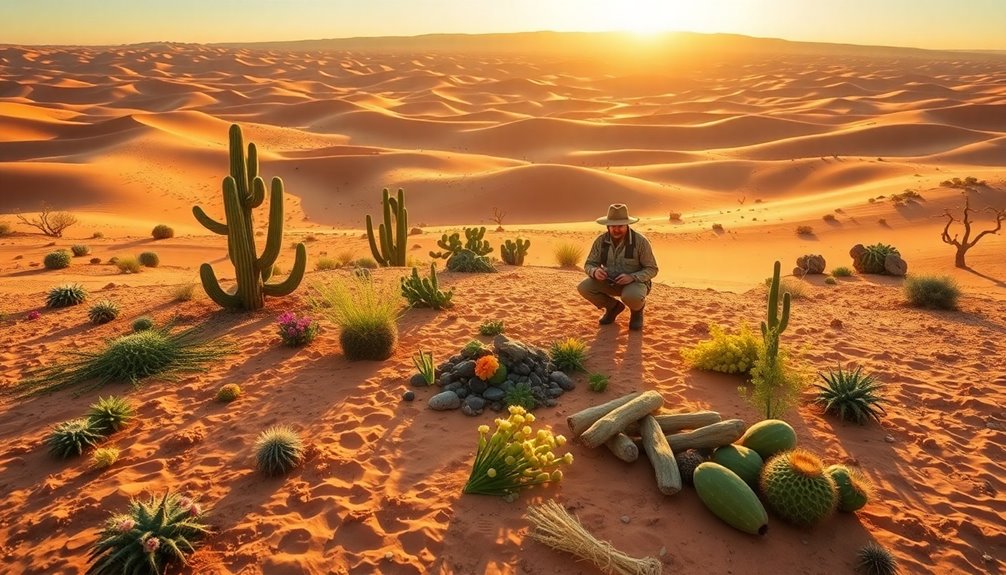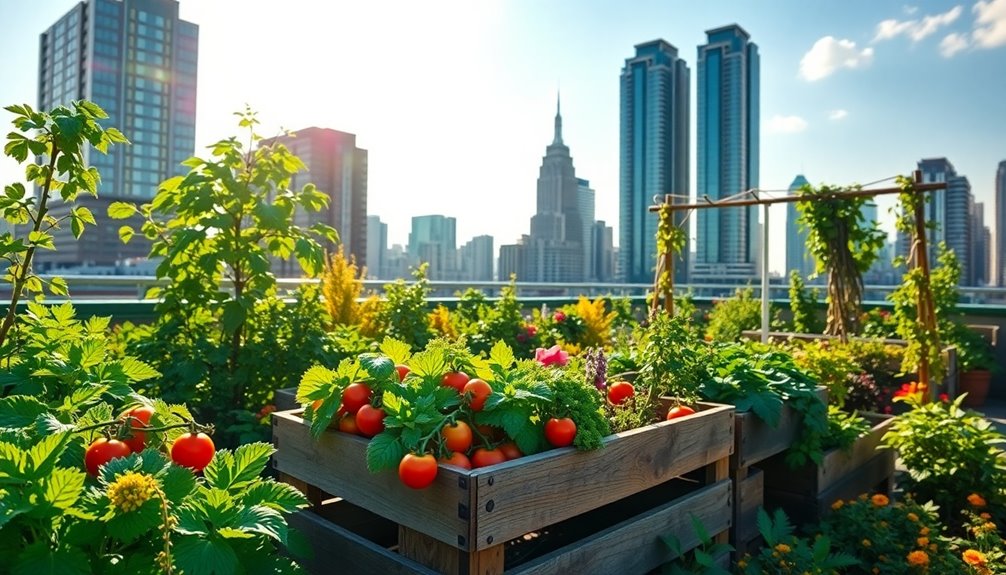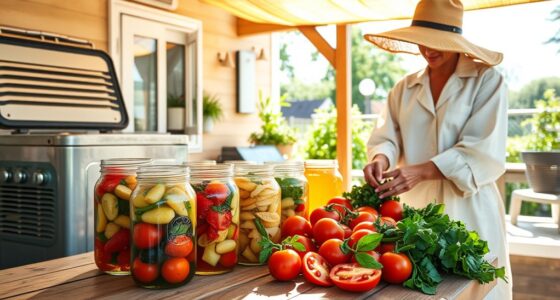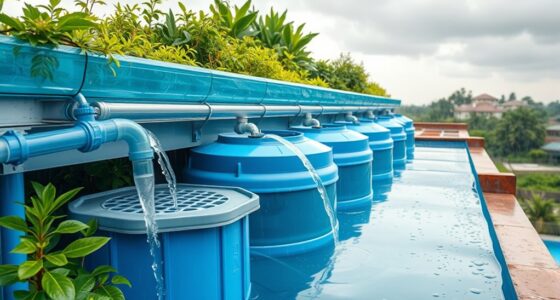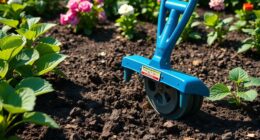In the desert, knowing what food you can find makes all the difference. Start with edible plants like prickly pear, mesquite, and yucca. They provide hydration and essential nutrients. Always double-check your plant identification since many toxic look-alikes exist. For hunting, teamwork is key; having a buddy makes foraging safer and more efficient. Be aware of seasonal availability—some plants are best gathered at specific times. Finally, practice ethical foraging to preserve these vital resources. For more tips on gathering and preparing food, there's plenty more to explore about thriving in the desert landscape.
Key Takeaways
- Familiarize yourself with local edible plants like prickly pear, mesquite, and yucca for hydration and nutrition in desert environments.
- Use field guides and engage in community workshops to enhance your plant identification skills and ensure safety when foraging.
- Be aware of seasonal availability; harvest prickly pear fruits in late summer and yucca roots in spring for optimal nutrition.
- Practice sustainable foraging techniques to preserve local plant populations and comply with regional regulations while gathering food.
- Always confirm plant identification using botanical names, and apply the Universal Edibility Test before consumption to avoid poisoning.
Introduction
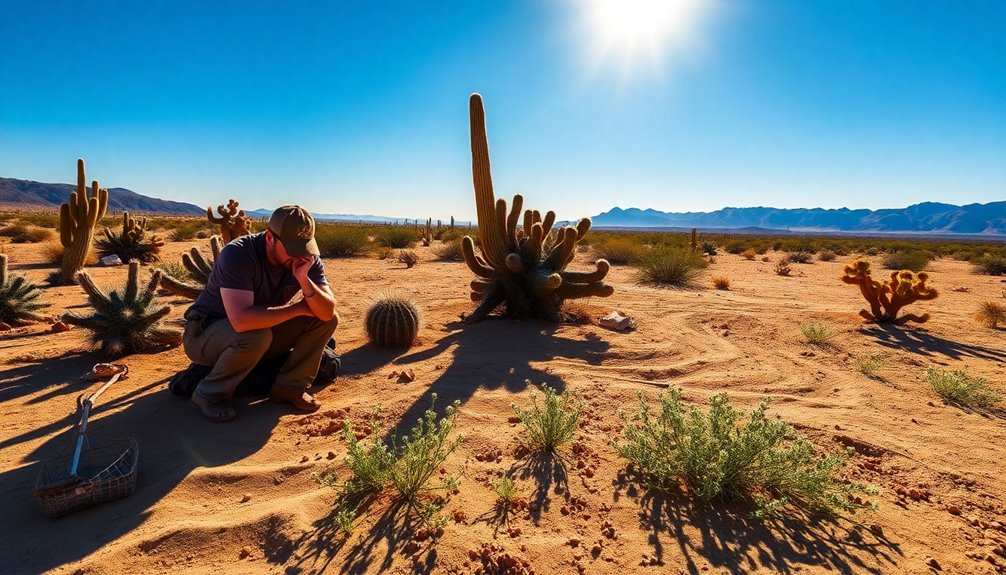
When you explore the desert, recognizing edible plants can mean the difference between survival and hunger.
By learning to identify key species like prickly pear and mesquite, you'll unlock a vital resource for nutrition and hydration.
With a bit of knowledge, you can navigate this seemingly barren landscape and make it a source of sustenance.
Desert Plant Identification Basics
Understanding the desert's unique ecosystem is essential for anyone interested in foraging. To successfully identify edible plants, familiarize yourself with local flora by consulting field guides specific to your desert region.
Focus on easily recognizable desert plants like prickly pear, mesquite, and yucca, which offer both food and hydration. Pay attention to key identifying features such as leaf shape, flower color, and growth patterns to boost your confidence in plant identification.
When uncertain about a plant's safety, practice the Universal Edibility Test, which helps you determine edibility while excluding mushrooms.
Additionally, consider joining local foraging groups or workshops to learn practical skills and gain insights from experienced foragers in your area. This knowledge is invaluable for safe foraging.
Survival Through Plant Identification
Identifying plants correctly can mean the difference between life and death in the desert. Proper plant identification is essential for finding survival foods, as many edible plants have toxic look-alikes.
In the Sonoran Desert alone, you can discover over 540 species of wild edibles. Familiarizing yourself with local flora, like the pads of prickly pear cactus or the seeds of chia sage, enhances your foraging success.
Always confirm your plant identification using botanical names and local guidebooks to avoid poisoning. Engaging in workshops or joining community foraging groups can provide invaluable insights into edible plants and their uses.
Plant Identification for Survival
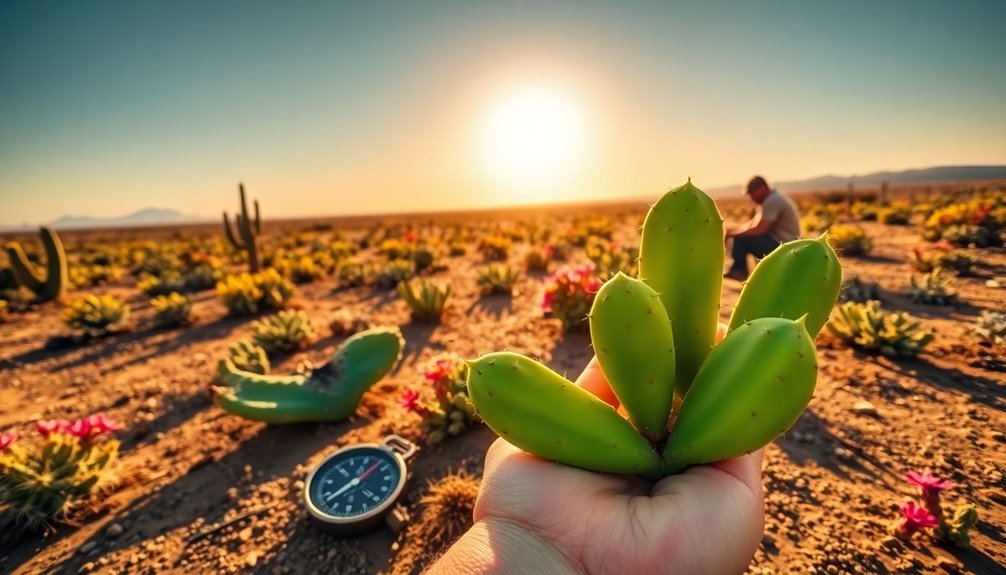
Foraging for food in the desert can be a rewarding experience, but success hinges on your ability to identify edible plants. Familiarize yourself with local species by consulting a guidebook and focusing on a few that are easy to recognize.
Proper plant identification is crucial since many edible plants have toxic look-alikes; always confirm by botanical name before eating. In a survival situation, you might use the Universal Edibility Test to gauge safety, but remember, it's not suitable for mushrooms.
Learn key characteristics of plants like prickly pear, mesquite, and yucca to improve your foraging success. Engaging with local foraging communities or workshops will further enhance your plant identification skills for gathering wild food. Additionally, understanding traditional healing practices can provide insights into the nutritional value of various plants in the region.
Nutritional Sources in Emergencies
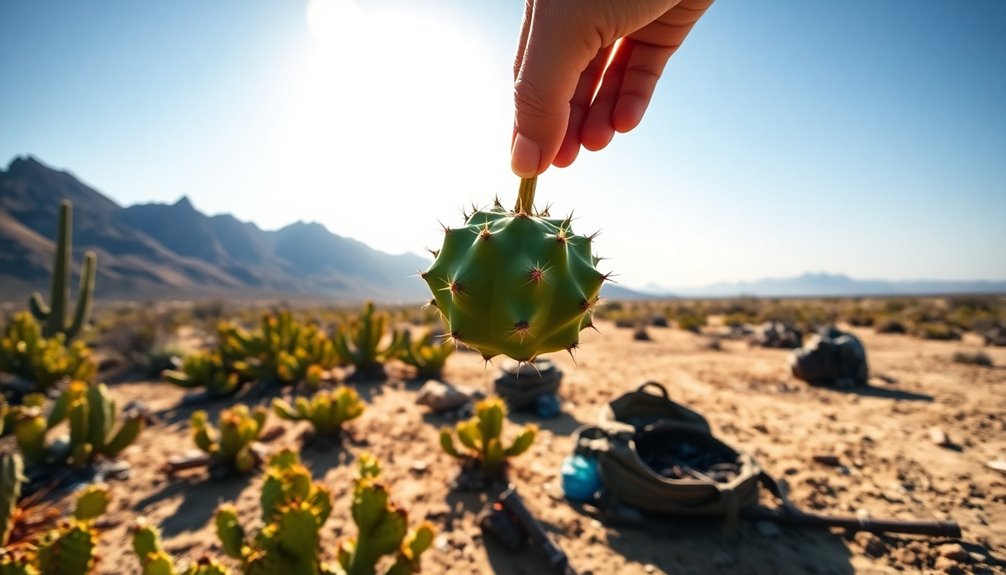
In emergencies, knowing nutrient-dense options can be a lifesaver in the desert.
You'll want to focus on plants that adapt well to the harsh climate, like prickly pear and mesquite.
These sources not only provide hydration and energy but also essential nutrients to keep you going.
Nutrient-Dense Desert Survival Options
Surviving in the arid desert can be daunting, but nature provides a wealth of nutrient-dense options to sustain you.
Prickly pear cactus, with its fruit containing about 85% water, is rich in vitamins C and B, essential for energy and immune support.
Mesquite pods pack a protein and fiber punch, perfect for grinding into gluten-free flour.
Don't overlook roasted agave hearts; they offer a sweet flavor with low glycemic benefits.
Chia sage seeds give you a quick energy boost, and the whole plant is edible.
Finally, yucca roots provide essential carbohydrates with a chestnut-like flavor when cooked.
Incorporating these nutrient-dense options can enhance your energy levels and overall vitality during survival situations.
Together, these edible plants form a solid foundation for survival food in the desert, ensuring you stay nourished during challenging times.
Desert Climate Adaptability
Desert environments demand quick adaptability, especially when it comes to finding nutritional sources in emergencies.
You can rely on several edible plants like prickly pear, mesquite, and yucca to sustain you. Prickly pear fruit, rich in vitamins C and B and about 85% water, is a great hydration source. Mesquite pods can be dried and ground into gluten-free flour, while fresh pods attract wildlife and provide sweetness.
Chia sage seeds offer short-term energy, showcasing how indigenous cultures thrived in desert survival. Cooking agave transforms it into a sweet treat, and its sap can be made into syrup. Additionally, being aware of wildlife interactions can enhance your foraging success, revealing the presence of these essential edible plants in the desert.
Foraging With a Buddy

Foraging with a knowledgeable buddy can transform the experience into an adventure filled with learning and safety.
When you team up, you enhance your ability to identify edible plants while avoiding toxic look-alikes. One of you can focus on a specific plant's details, while the other learns about various species nearby, mimicking the communal practices of Native Americans.
An experienced partner can share proper harvesting techniques, showing which parts of the plant are safe to consume, crucial for wilderness survival.
Plus, having a companion boosts efficiency; one gathers resources while the other prepares food or documents findings.
Finally, foraging in pairs provides security in remote areas, ensuring better navigation and communication in case of emergencies.
Foraging Gear Essentials
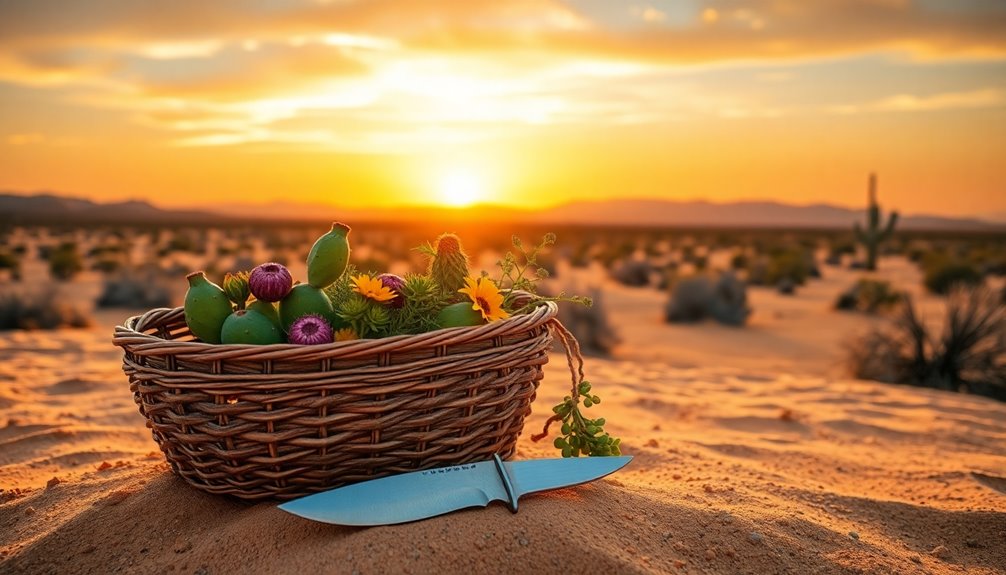
When heading out to explore the wilderness with a friend, packing the right gear can make all the difference.
Start with a sturdy, flexible backpack to comfortably carry your foraging gear while navigating rugged terrain. A reliable field guide is essential for identifying edible plants and mushrooms, helping you avoid toxic look-alikes.
Don't forget a multi-tool or knife; it's crucial for harvesting plants and preparing food. Staying hydrated in the desert is vital, so pack a water bottle or hydration system to fend off dehydration.
Lastly, a first aid kit with antiseptic wipes and band-aids can address any minor injuries or reactions during your adventure. Additionally, consider incorporating multi-functional gear into your pack to maximize space and efficiency on your foraging trip.
With the right essentials, you'll be well-prepared for a successful foraging trip!
Foraging Safety Protocols
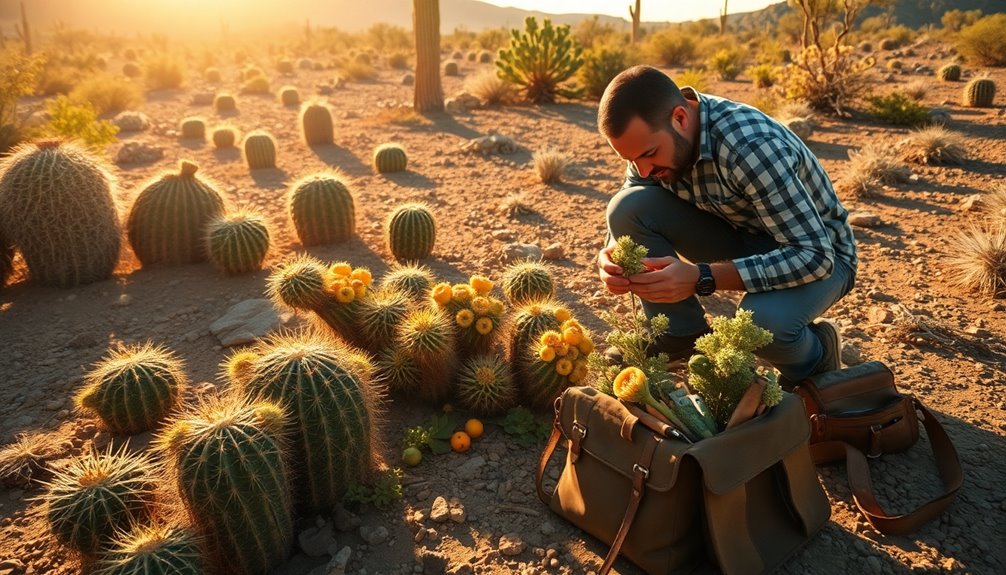
Safety is paramount when exploring the world of wild edibles. Always confirm 100% plant identification before consumption because many edible plants have poisonous look-alikes that can result in severe health issues.
Use a local guidebook or app to enhance your foraging safety by accurately identifying edible and poisonous plants. When you're unsure, practice the Universal Edibility Test: isolate one plant part, wait several hours, and observe for any reactions, but skip mushrooms due to their high toxicity risks.
Additionally, avoid foraging near heavily traveled roads to diminish exposure to toxins from vehicle emissions. Lastly, wear gloves when handling unknown plants to protect your skin and ensure safe foraging practices.
Stay vigilant and informed!
Identifying Toxic vs. Edible Plants
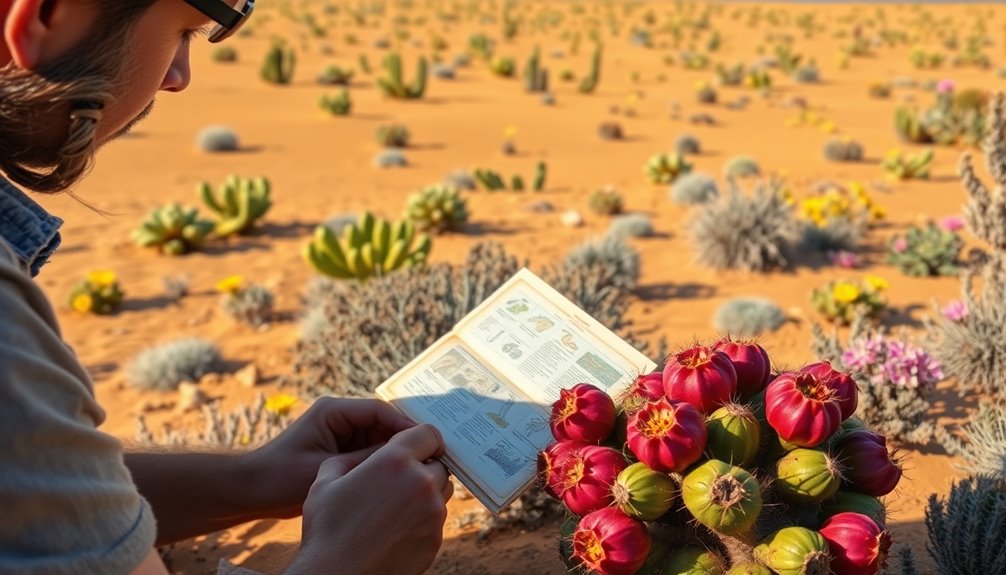
When foraging in the desert, knowing the seasonal availability of plants is crucial for identifying what's safe to eat.
You need to be aware that many edible plants can look similar to toxic ones, so using safe foraging techniques is essential.
Familiarizing yourself with local flora will help you avoid dangerous mistakes and make informed choices.
Desert Plant Seasonal Availability
Navigating the desert's diverse plant life can be both rewarding and challenging, especially when it comes to identifying edible versus toxic varieties.
Understanding seasonal availability is crucial; for instance, prickly pear fruits are typically harvested in late summer, while cactus pads are best collected in spring when they're tender.
Many edible plants, like yucca, have specific harvesting times—its flowering stalks are edible in spring, but the roots need cooking to remove toxicity.
Toxic plants often mimic safe ones, so always check botanical names.
Familiarity with local flora enhances your ability to identify which plants are edible and which are not, ensuring you find a reliable source of food throughout the seasons while practicing safe foraging.
Safe Foraging Techniques
Foraging in the desert can be an exciting adventure, but it's vital to know how to distinguish between toxic and edible plants.
Always ensure 100% identification before consuming any plant, as many edible plants have toxic look-alikes that can cause severe health issues.
Use a local guidebook or app with clear images and descriptions to help you identify safe edible plants.
Familiarize yourself with common toxic plants like the Death Cap mushroom and Monkshood to avoid accidental ingestion.
If you're uncertain about a plant's edibility, err on the side of caution—don't eat it. Additionally, be aware that some plants may contain essential oils that can be harmful if ingested without proper knowledge.
Successful Foraging Survival Stories
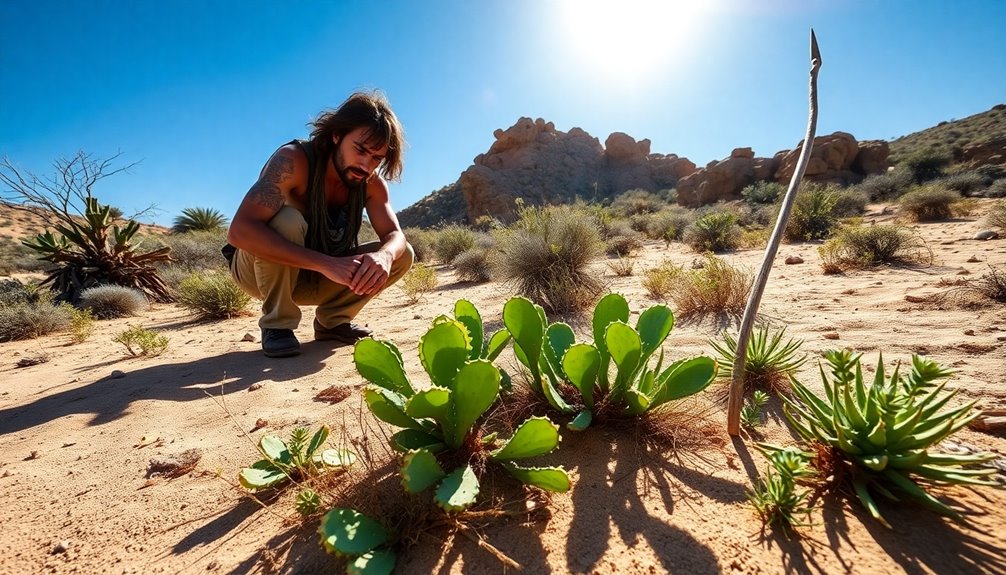
In the heart of the desert, countless survival stories emerge from individuals who've turned to the land for sustenance. Many have relied on wild plants like the prickly pear cactus to survive and thrive during challenging outdoor excursions.
For instance, foragers often share how the nutrient-dense pads of the prickly pear and the high-energy seeds of chia sage kept them strong and healthy while navigating arid environments. These tales highlight the critical importance of proper plant identification, as mistakes can lead to serious health risks. Additionally, the psychological benefits of foraging enhance your connection to nature, boosting confidence in your wilderness skills. By learning from seasoned foragers, you can master harvesting techniques and appreciate the ecological significance of maintaining plant populations.
Moreover, understanding the importance of sustainable harvesting practices can ensure that these valuable resources remain available for future generations.
Conclusion
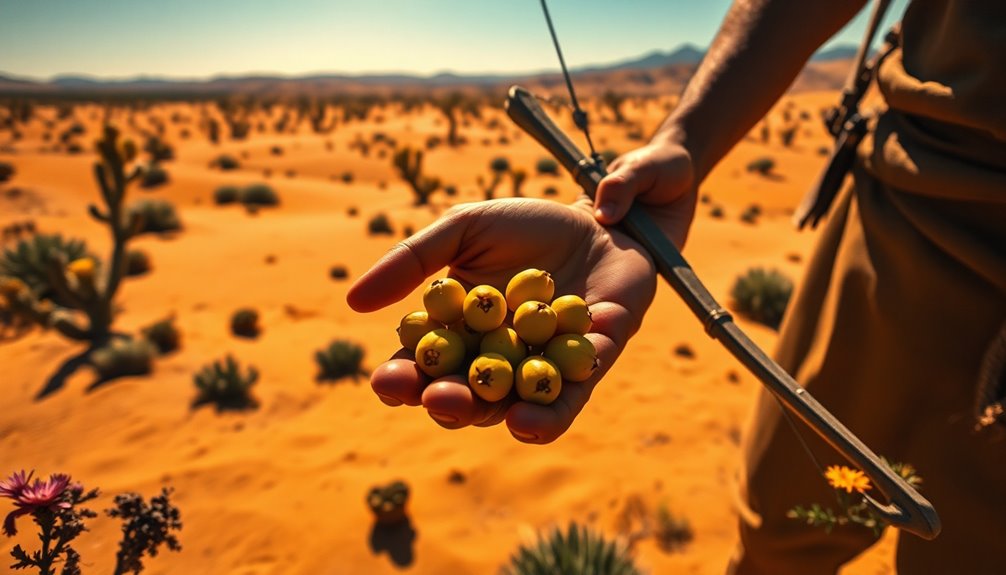
Embracing the art of foraging in the desert offers more than just sustenance; it deepens your connection to the environment and enhances your survival skills.
By learning to identify and harvest edible plants like prickly pear, mesquite, and yucca, you gain essential nutritional benefits while fostering self-reliance. Understanding local regulations ensures you forage ethically, protecting vital species like saguaros.
Engaging in these practices not only boosts your physical activity but also equips you with the knowledge to navigate the desert landscape safely.
Seasonal awareness and preparation methods are crucial to maximizing the benefits of your foraging endeavors.
Ultimately, mastering these skills can transform your experience in the desert, making it both enriching and life-sustaining.
Additional Resources
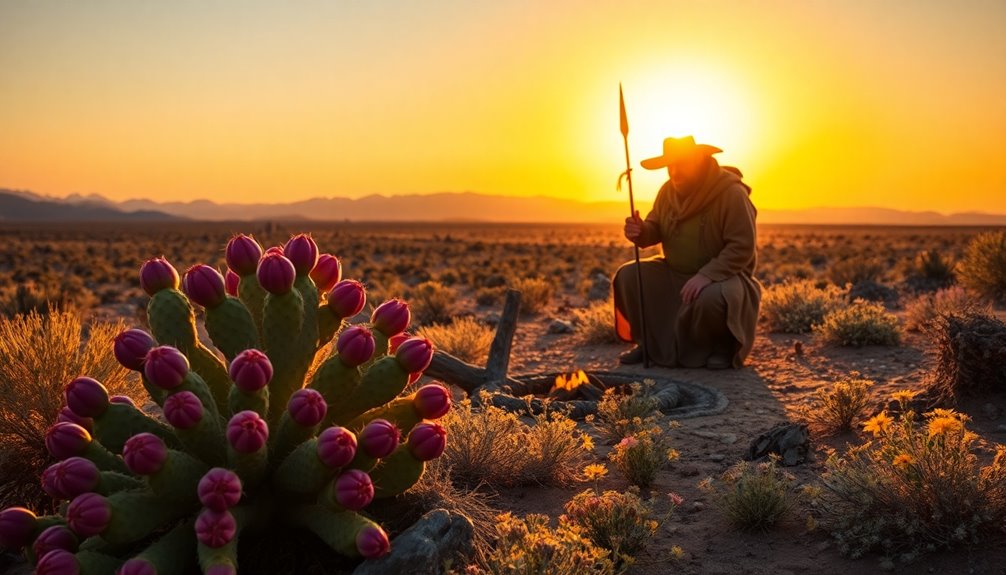
To enhance your foraging journey in the desert, several valuable resources can guide you along the way. Explore local guidebooks that detail over 540 edible plant species in the Sonoran Desert, helping you distinguish between safe and poisonous options.
Engaging with the community is crucial; attend workshops or join online forums to share experiences and tips with fellow foragers. Resources like DesertUSA offer newsletters packed with information about local flora, hiking, and camping advice, making them indispensable for your foraging efforts.
Additionally, understanding seasonal changes and wildlife interactions will significantly enhance your foraging success and promote sustainable harvesting practices. Consider looking into urban foraging essentials, which can provide insights on identifying edible plants in various environments.
With these tools at your disposal, you'll be well-equipped to navigate the desert's culinary landscape.
Frequently Asked Questions
How Do People Find Food in the Desert?
People find food in the desert by honing their foraging skills and understanding local wildlife.
You can identify nutrient-rich plants like prickly pear and yucca, which offer essential vitamins.
Hunting small game, such as rabbits and quail, is another viable strategy, especially near water sources.
Join community foraging groups or workshops to sharpen your skills, learn about seasonal availability, and enhance your ability to locate food in this challenging environment.
What Food Do People Eat in Deserts?
In deserts, you'll find people eating a variety of native plants and animals that thrive in harsh conditions.
They often rely on prickly pear and mesquite for hydration and nutrients, while chia sage and wolfberries provide essential vitamins.
Hunting quail and rabbits adds protein to their diets.
Seasonal foods, like pinyon pine nuts and yucca, are harvested at the right times to maximize availability, ensuring survival in the challenging desert environment.
What Food Do Animals Eat in the Desert?
In the desert, animals adapt their diets to survive in harsh conditions.
You'll find rodents and birds munching on seeds and fruits, while herbivores like desert bighorn sheep graze on tough grasses and cacti.
Insects sip nectar from flowers, playing a role in pollination.
Carnivores, such as coyotes, feast on small mammals and birds but don't shy away from fruit when it's available.
Each animal's diet reflects the unique resources of the desert environment.
Are There Any Edible Plants in the Desert?
Yes, there are plenty of edible plants in the desert!
You can find prickly pear cactus, which offers nutritious pads and fruits packed with vitamins.
Mesquite trees provide sweet pods that you can dry and grind into flour.
Don't overlook yucca plants; their flowers are tasty raw, and the roots can be cooked for a safe meal.
Cholla cactus also gives you edible flower buds and pads that are perfect for grilling.
Enjoy exploring!

